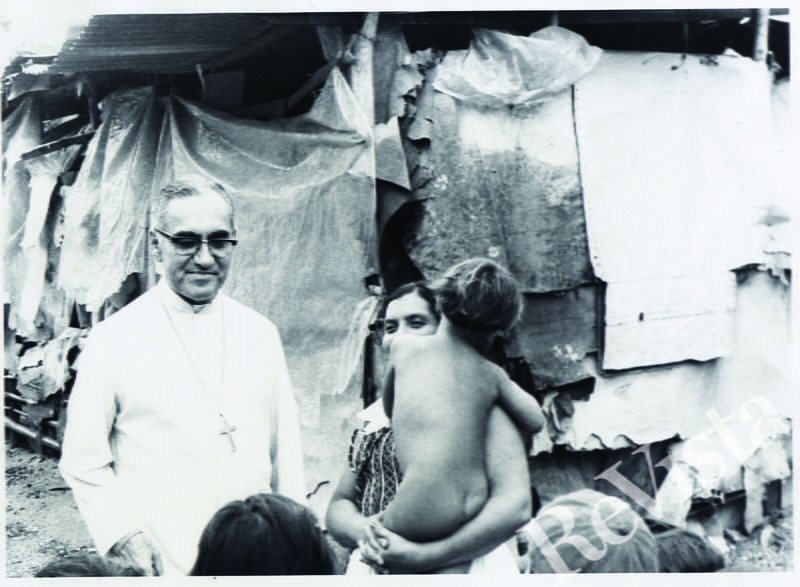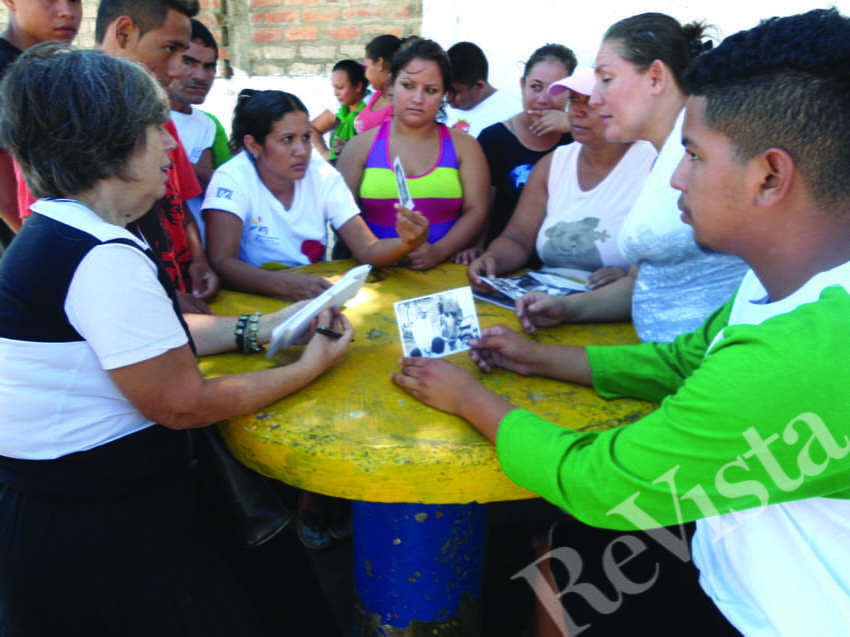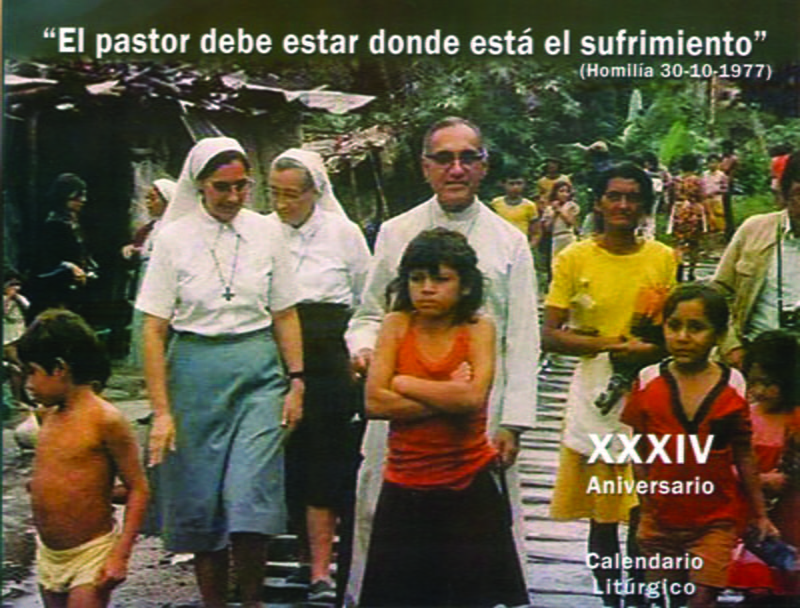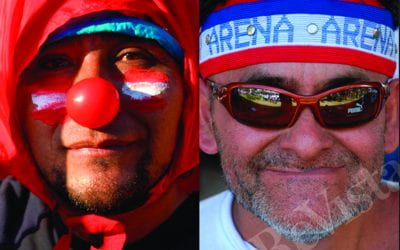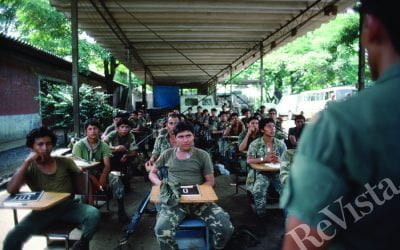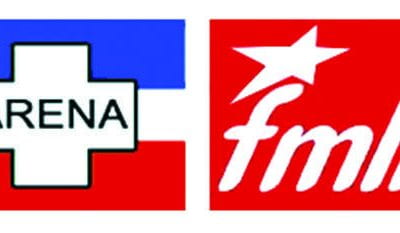The Boy in the Photo
Return to La Chacra
The mangy dogs strolled everywhere along the railroad track. I remembered dogs just like them from the long-ago day in La Chacra in 1979 with Archbishop Óscar Romero, just months before he was killed.
Dogs were everywhere. So were children. I wondered how the archbishop kept his robe so pristine white amidst the mud and ramshackle shacks. We talked for a long time with Alicia Campos, a community member active in both religious affairs and housing rights. She told the archbishop about the local problems. A catechist was accused of being a guerrilla. Small Bible study groups were afraid of being suspected of revolutionary activity and now met in secret. It was getting harder to organize people to demand housing rights because of fear, she said.
“I often stop to think,” Romero told me at the time, “how the first cause of deaths in El Salvador is diarrhea from parasites and poor nutrition. And the second cause is homicide…violence.”
La Chacra was then an abysmally poor community snuggled between the river and the railroad tracks. Many of the houses were thrown together from cardboard, tin and cast-off building material. I spent the afternoon walking with Romero, listening to community members and taking photos.
That night, Romero would write in his diary about how he and journalists witnessed “different aspects of the miserable but happy and Christian life of the community of La Chacra. I went in houses where the rain that is falling is making the walls and floors damp. Often, the wall is the cliff itself, to which a metal roof has been attached. When they left, the journalists were impressed by this situation of misery and human proliferation—there were children all over the place.” (Archbishop Óscar Romero, A Shepherd’s Diary, St. Anthony’s Press, 1983).
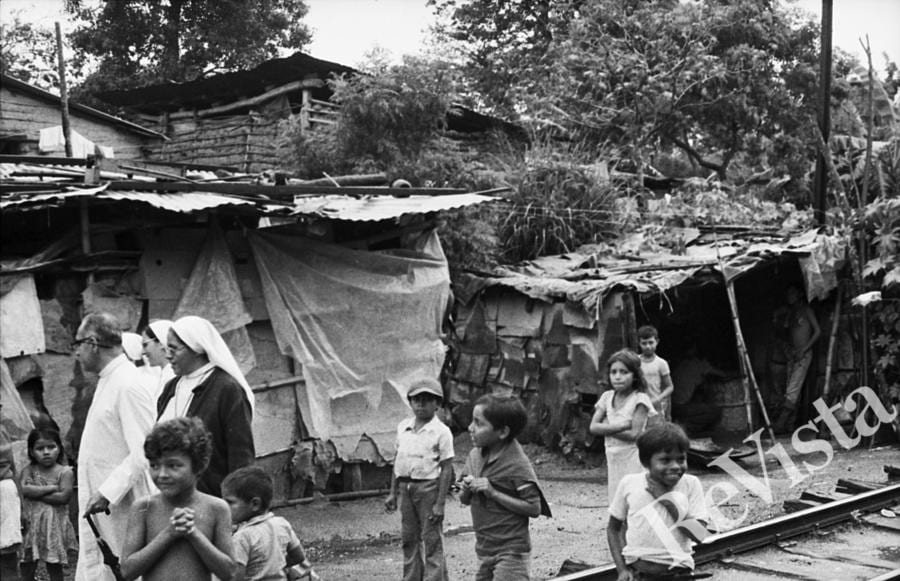
Óscar Campos (in center of photo with improvised Superman cape) follows Archbishop Romero with other children and nuns, La Chacra, 1979.
I remembered the dogs. He remembered the children. After Romero was assassinated in 1980, one of the photos I had taken that day in La Chacra for the National Catholic Reporter suddenly became iconic. It showed Romero in his pristine white robe talking to a woman holding a naked child, a boy just a bit too old to be naked. It was somewhat of a Madonna pose, and the image found itself on T-shirts, posters, liturgical calendars.
I had tried once before to go back to La Chacra to find the mother and child, but had been told it was too dangerous. This time, in November 2015, I was determined to visit the community. I wrote to everyone I could think of for help. The Salvadoran Foundation for the Development of Basic Housing, known by its Spanish acronym as FUNDASAL, came to the rescue. It had been working with poor neighborhoods, including La Chacra, since 1968.
I told Claudia Handal, the urban development specialist for FUNDASAL, what I remembered about the neighborhood and we pinpointed the area of La Línea near what used to be the Fe y Alegría school (some people don’t even like to call the area La Chacra, but Romero did, so I will too).
We went door to door with the photo of the woman and the little boy. Alicia Campos, many people said. She went to the States a long time ago and died there. The boy might be there too. The house is now a cinderblock evangelical church. Indeed, most of the houses in the neighborhood are now cinderblock, some with satellite dishes, many lacking in basic services like water and garbage collection. Police cars linger on the fringes of the community.
La Chacra is divided up among three rival gangs, Handal and other sources tell me. FUNDASAL is trusted, and doors open readily as we canvas the neighborhood. Some run up to Handal to thank the community organization for a housing loan, for their “casita.” Fear is not apparent, but I am soon to learn it is there.
Handal has organized a community gathering for me. The youth, she tells me, cannot cross over into the area we have visited because of gang rivalries. Melvin Rivera, 16, tells me in a plaintive voice, “We are discriminated against because we are young. We can’t study or do internships because of the gangs. We’re afraid. We’re afraid we’ll get killed because of our age.”
Rina del Carmen Campos’ son almost did get killed. He was studying medicine at the National University and returned home one evening around 5 p.m. last May. Two young men hit him over the head with a pistol and then beat him up, hitting his legs over and over again. Campos thinks the motive was robbery, but she’s not sure. Her son is still recuperating; he may not go back to school.
Over and over, mothers tell me about keeping their children out of school—even grade school—because of fear of recruitment, robbery and in the case of young girls, rape and abduction. There’s also fear of police brutality. Many of the youth I spoke with are working in the government’s Proyecto Pati, a temporary work program that helps youngsters earn money by cleaning up streets and doing other community-based jobs. More than once, various youth said, police came and beat them up even while they were wearing government-issued uniforms (the National Police did not return calls asking to comment on the situation). The Workers’ Union (Intergremial de Trabajadores) of the Salvadoran Education Ministry says that 15 teachers and 50 students were assassinated in El Salvador in 2015, compared with 14 teachers and 38 students in 2014.
Later that day in the FUNDASAL offices, Edin Martínez, the former executive director of the organization, commented, “It was dangerous then to go out to greet Archbishop Romero. It was dangerous to have a Bible. It is still dangerous to be young in El Salvador.”
He does not recognize the mother and child in the photo, but he is not surprised that they might have gone “North,” as Salvadorans term the migration to the United States. Before we left La Chacra, Handal and I had talked to a woman in the parish office who thought she might know a friend of the boy in the photo. She’d try to contact him by Facebook, she said.
I saw her again on my second trip to La Chacra at a Sunday mass at Maria, Madre de los Pobres. A second contact had emerged: Mauricio Morales, a chemical engineer who had grown up in the neighborhood, and had just happened to study for his Master’s at the Universidad Centroamericana (UCA) with my friend, former Boston College professor Father Douglas Marcouiller, who had once lived in La Chacra.
I was a little afraid to go back to La Chacra. Would gang members think I was a spy? Morales reassured me. The mass, led by Father Luis Salazar, was packed. He showed the photo of the mother and child to the congregation during his homily. A lively musical group played many of the songs I remembered from the 70s and 80s, songs inspired by liberation theology, by recognition of the plight of the poor. I felt transported back in time.
Morales is also a legacy of the neighborhood. He had spent his time after school reading in the Fe and Alegría library, then earning scholarship after scholarship. He is now thinking of pursuing a doctorate in the United States. He still maintains his ties to the old neighborhood, especially to the church.
After the second visit, I returned to the States, to my job as editor-in-chief of ReVista to prepare the issue about El Salvador. Then, one day, sitting in my office, answering my endless e-mail, I found a message with the subject line “Small boy in the photo.” The message read, “Recently, I was made aware that the journalist who took the attached photo was interested in communicating with the individuals in the photo. I happen to be the small boy wearing a red shirt and shorts (right hand side).”
The message was from Óscar Campos, Alicia Campos’ son. And there he was, with Romero, a group of nuns and many children, walking along the railroad tracks. The photo, however, was not mine. I sent him a copy of my photo. Óscar seemed older than the naked boy in my photo, and he emphasized that his grandmother, Alicia Campos, who raised him, never allowed him to run naked “like many of the other boys.”
“It is quite interesting how a single photo can transport the human mind to a moment in time long lived,” he wrote me in an e-mail. “And in a fraction of a second, we find ourselves reliving our childhood once again.”
Óscar confirmed that his grandmother had died a few years back and that she had been the housing activist Romero and I had talked to. Not long after Romero’s visit, he and his grandmother had taken a tourist bus to Mexico, crossing the U.S.-Mexico border on foot to reunite with Óscar’s mother in Los Angeles. They received immigration amnesty under the Reagan administration, and he now works as a chief operating officer for an export company in Los Angeles.
A few days after I talked to Óscar Campos on the phone from Cambridge, I searched through other photos I had taken for the National Catholic Reporter on La Chacra visit. There he was in my photo wearing an improvised “Superman cape” and trailing Archbishop Romero.
And the boy in the first photo? Campos may work in finance and administration, but he told me he sometimes dreams of being a journalist or chef. Using those journalistic instincts, with just a few inquiries, he identified the woman and the child as Niña Chave (the nickname for Miss Isabel) and her son Nelsy.
So today the boy with Romero in a photo, now a Los Angeles businessman, is helping me search for the boy in the other photo. As Archbishop Romero observed in his diary, there were many children that day.
Spring 2016, Volume XV, Number 3
June Carolyn Erlick is the editor-in-chief of ReVista, the Harvard Review of Latin America. She reported from El Salvador for the National Catholic Reporter and other publications from 1977-1988.
Related Articles
Beyond Polarization in 21st-century El Salvador
My father was a civil engineer who worked for the government during the civil war years. He specialized in roads and had to spend several days a month traveling to remote places in El Salvador. I was 10 in 1986, and I remember my mom asking my dad…
El Salvador: Editor’s Letter
I had forgotten how beautiful El Salvador is. The fragrance of ripening rose apples mixed with the tropical breeze. A mockingbird sang off in the distance. Flowers were everywhere: roses, orchids, sunflowers, bougainvillea and the creamy white izote flower…
The Salvadoran Right Since 2009
English + Español
In 2009, as the FMLN celebrated its long-awaited first foray into the Casa Presidencial, El Salvador’s largest conservative party—the Nationalist Republican Alliance (Alianza Republicana…

